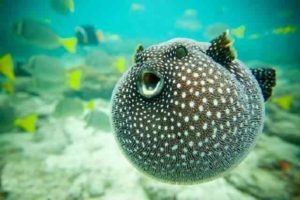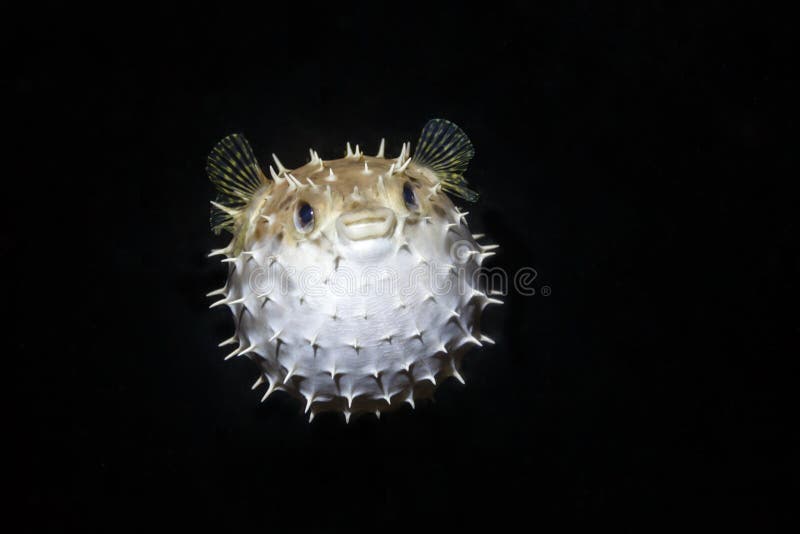

It was at this stage of their evolution that they gained the ability to inflate themselves. The next step along the tree carries the ancestors of pufferfish past the point where they branched away from the triggerfish lineage. I’ve worked on tripodfish and I’ve tried everything I could to seduce them into a situation where a blowing behavior would be useful, and they would never do it. There’s no reason the tripodfish can’t blow water, but they don’t, says Wainwright. During water-blowing, the muscles compressing a triggerfish’s cheekbones squeeze a little harder and for a longer time otherwise the complex pattern of muscle contractions is the same. Yet as different as coughing and water-blowing may seem, Wainwright can find only one difference associated with the change from one to the other. Two other species of triggerfish I’ve seen in Hawaii eat by exposing invertebrates in the sand by shooting these jets of water, says Wainwright. These spurts can be aimed at other targets as well. In this way the fish expose the soft, fleshy underside of the urchin that they then tear into. I noticed that triggerfish will attack sea urchins by grabbing one by a single spine, lifting the animal off the bottom, ducking under the animal, and then blowing at it to turn it over. Wainwright first encountered their skill while scuba diving in the Caribbean. Tripodfish don’t take advantage of this jet of water, but if you take another step along the tree, you find a group of fish-triggerfish and their close relatives-that do.

If you exhale the same volume of water through a small aperture, you get a more directed, controlled flow, which can be aimed and which has a higher velocity, says Wainwright. As minor as these changes may be, the smaller mouth has a strong effect on the flow of water in a cough. Wainwright has found only minor changes among them associated with coughing: their mouths (which are smaller than those of other fishes their size) open wide for a fifth of a second-letting more water rush in-before they close their gills and squeeze their cheeks in. The first tetraodontiforms to branch away on their own were probably much like today’s tripodfish. The increase in pressure expels the water in the mouth cavity and whatever gunk may be floating in it. Fish, he has found, typically cough by closing off the gill slits through which the water would normally flow and then compressing the cheeks inward. Wainwright has made a careful study of the muscle activity patterns in fish and can make out the timing of individual muscles down to less than a thousandth of a second. After eating a couple of earthworms, every sunfish I’ve seen will pause-and it’s almost as if you see it going, ahem, ahem-and it’ll cough up a bunch of this mucus that has gotten entangled in its gills. We often feed them earthworms, and earthworms have this slimy mucus on them. And, according to Peter Wainwright, a Florida State University biologist, along the way you can see how the remarkable trait of pufferfish inflation was created out of nothing more than coughing.īefore the tetraodontiforms branched away, they probably resembled the sunfish that Wainwright studies in his lab. Using the evolutionary tree of pufferfish and their relatives illustrated on this page, you can trace the development of the pufferfish’s unique anatomy. These tropical fish include the pufferfish’s closest relatives, species like triggerfish and tripodfish. Pufferfish belong to an order of fishes known as Tetraodontidae. They’ve discovered that pufferfish are yet another example of a surprisingly common pattern in evolution: features that look like radically new innovations turn out to be, on a fundamental level, a matter of minor tinkering. In the past few years researchers have learned much about how pufferfish puff and have found some striking similarities in the behavior of their relatives. But fossils aren’t the only way to reconstruct evolutionary history. Given that fossils are too scant and scrappy to offer any clues, biologists have been reluctant to hazard a guess. How could anything like this evolve from an ordinary fish?

But when a predatory fish or bird attacks, a pufferfish goes through a unique transformation: it rapidly gulps water and swells into a huge, spiky, hard-shelled ball three times its normal size. At first sight, it seems miserably adapted to the tropical waters where it makes its home: it is an unassuming, small fish, so slow you can easily catch it by hand. The puzzle-and joy-of evolutionary biology is to find the lost paths that life took to arrive at the strange forms it has today.


 0 kommentar(er)
0 kommentar(er)
